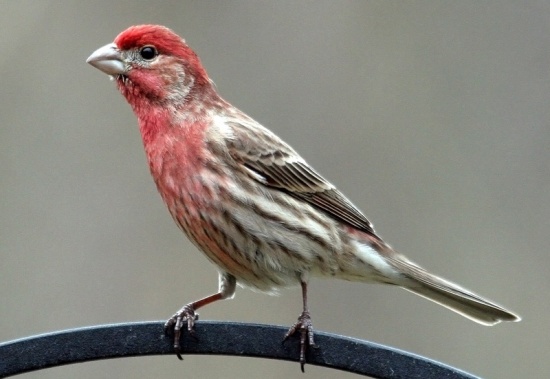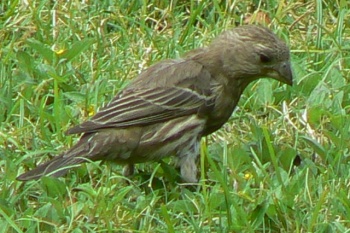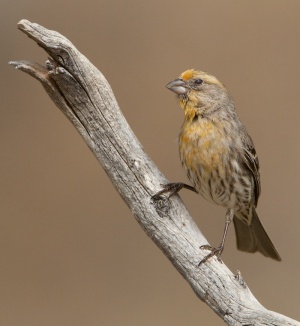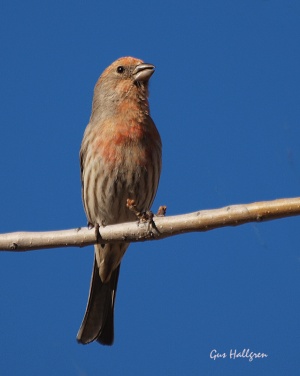(genus change (Clements and IOC)) |
|||
| (22 intermediate revisions by 10 users not shown) | |||
| Line 1: | Line 1: | ||
| − | + | [[Image:House_Finch.jpg|thumb|550px|right|Male<br/>Photo by {{user|skiel|skiel}} <br />Orange County, [[New York]], [[USA]], March 2006]] | |
| − | [[Image:House_Finch.jpg|thumb|550px|right|Photo by skiel | + | ;[[:Category:Haemorhous|Haemorhous]] mexicanus |
| − | + | ''Carpodacus mexicanus'' | |
==Identification== | ==Identification== | ||
| − | + | L. 5-6" (13-15 cm)<br /> | |
| − | Distribution== | + | '''Male'''<br /> |
| − | + | Bright red on crown, breast, and rump. A yellow carotinoid variant is sometimes seen (photo below).<br /> | |
| + | '''Female'''<br /> | ||
| + | Plain, unstriped head and heavy streaking on light underside | ||
| + | [[Image:HouseFinchFemale_Honolulu.JPG|thumb|350px|right|Female<br />Photo by {{user|AlanR|AlanR}}<br />[[Honolulu]], March 2007]] | ||
| + | '''Immature males'''<br /> | ||
| + | Less highly coloured, often orangish or yellowish on head and breast | ||
| + | |||
| + | '''Geographical variation'''<br /> | ||
| + | In north-west Mexico is a region where House Finch males are extensively red and with much less brownish streaking on the underside<sup>[[#References|[2]]]</sup> (probably subspecies ''ruberrimus''). | ||
| + | ==Distribution== | ||
| + | [[North America]], [[Canada]] to southern [[Mexico]] | ||
==Taxonomy== | ==Taxonomy== | ||
| + | Formerly placed in genus [[:Category:Carpodacus|Carpodacus]]. | ||
| + | ====Subspecies==== | ||
| + | [[Image:Housefinch yellow variant.jpg|thumb|300px|right|The yellow carotinoid variant<br />Photo by {{user|digishooter|digishooter}}<br />Kern Co, CA, [[USA]], May 2011]] | ||
| + | This is a [[Dictionary_M-S#M|polytypic]] species consisting of twelve subspecies<sup>[[#References|[1]]]</sup>: | ||
| + | *''H. m. frontalis'': South-western [[Canada]] to western [[US]], [[Baja California]] and north-western [[Mexico]] | ||
| + | *''H. m. clementis'': Channel Islands (off southern [[California]]) and Los Coronados Islands (off northern Baja) | ||
| + | *''H. m. amplus'': Guadalupe Island (off [[Baja California]]) | ||
| + | |||
| + | *''H. m. ruberrimus'': Southern [[Baja California]] and north-western [[Mexico]] (Sonora, southern Sinaloa and south-western Chihuahua) | ||
| + | *''H. m. rhodopnus'': Arid tropical central Sinaloa | ||
| + | *''H. m. coccineus'': Mountains of south-western [[Mexico]] (southern Nayarit and western Zacatecas to western Michoacán) | ||
| + | *''H. m. potosinus'': Southern [[Texas]] (Rio Grande Valley) to Chihuahua and south-western Tamaulipas | ||
| + | *''H. m. centralis'': Central [[Mexico|Mexican]] plateau (Guanajuato, Querétaro and adjacent states) | ||
| + | *''H. m. mexicanus'': South central [[Mexico|Mexican]] plateau (eastern Michoacán to Hidalgo and Oaxaca) | ||
| + | *''H. m. roseipectus'': Southern [[Mexico]] (southern Puebla and Valley of Oaxaca) | ||
| + | [[Image:House-Finch4.jpg|thumb|300px|right|Young Male<br />Photo by {{user|UncleGus_24|UncleGus_24}}<br />Green Valley, [[Arizona]], [[USA]], February 2010]] | ||
| + | *''H.. m. griscomi'': South-western [[Mexico]] (Sierra Madre del Sur of Guerrero) | ||
| + | |||
| + | *''H. m. mcgregori'': Formerly San Benito and Cedros island (off [[Baja California]]). Extinct | ||
==Habitat== | ==Habitat== | ||
| − | + | Deserts, orchards, coastal valleys and forests. | |
| − | |||
==Behaviour== | ==Behaviour== | ||
| − | + | ====Breeding==== | |
| − | + | A tightly woven, compact nest is made and set in a bush, thicket, natural cavity, or on a building. The clutch consists of 3-5 bluish, lightly streaked or spotted eggs. | |
| − | + | ====Diet==== | |
| − | + | Diet includes insects and grass seeds. | |
| − | + | ==References== | |
| + | #{{Ref-Clements6thAug11}}#[http://www.birdforum.net/showthread.php?p=1732763#post1732763 Birdforum thread] discussing redder House Finch in Mexico | ||
| + | {{ref}} | ||
==External Links== | ==External Links== | ||
| − | + | {{GSearch|Finch+mexicanus}} | |
| − | [[Category:Birds]] | + | <br /> |
| + | {{Video|House_Finch}} | ||
| + | [[Category:Birds]][[Category:Haemorhous]] [[Category:Videos]] | ||
Revision as of 20:40, 1 February 2013
- Haemorhous mexicanus
Carpodacus mexicanus
Identification
L. 5-6" (13-15 cm)
Male
Bright red on crown, breast, and rump. A yellow carotinoid variant is sometimes seen (photo below).
Female
Plain, unstriped head and heavy streaking on light underside
Immature males
Less highly coloured, often orangish or yellowish on head and breast
Geographical variation
In north-west Mexico is a region where House Finch males are extensively red and with much less brownish streaking on the underside[2] (probably subspecies ruberrimus).
Distribution
North America, Canada to southern Mexico
Taxonomy
Formerly placed in genus Carpodacus.
Subspecies
This is a polytypic species consisting of twelve subspecies[1]:
- H. m. frontalis: South-western Canada to western US, Baja California and north-western Mexico
- H. m. clementis: Channel Islands (off southern California) and Los Coronados Islands (off northern Baja)
- H. m. amplus: Guadalupe Island (off Baja California)
- H. m. ruberrimus: Southern Baja California and north-western Mexico (Sonora, southern Sinaloa and south-western Chihuahua)
- H. m. rhodopnus: Arid tropical central Sinaloa
- H. m. coccineus: Mountains of south-western Mexico (southern Nayarit and western Zacatecas to western Michoacán)
- H. m. potosinus: Southern Texas (Rio Grande Valley) to Chihuahua and south-western Tamaulipas
- H. m. centralis: Central Mexican plateau (Guanajuato, Querétaro and adjacent states)
- H. m. mexicanus: South central Mexican plateau (eastern Michoacán to Hidalgo and Oaxaca)
- H. m. roseipectus: Southern Mexico (southern Puebla and Valley of Oaxaca)
- H.. m. griscomi: South-western Mexico (Sierra Madre del Sur of Guerrero)
- H. m. mcgregori: Formerly San Benito and Cedros island (off Baja California). Extinct
Habitat
Deserts, orchards, coastal valleys and forests.
Behaviour
Breeding
A tightly woven, compact nest is made and set in a bush, thicket, natural cavity, or on a building. The clutch consists of 3-5 bluish, lightly streaked or spotted eggs.
Diet
Diet includes insects and grass seeds.
References
- Clements, JF. 2011. The Clements Checklist of Birds of the World. 6th ed., with updates to August 2011. Ithaca: Cornell Univ. Press. ISBN 978-0801445019. Spreadsheet available at http://www.birds.cornell.edu/clementschecklist/downloadable-clements-checklist
- Birdforum thread discussing redder House Finch in Mexico
Recommended Citation
- BirdForum Opus contributors. (2024) House Finch. In: BirdForum, the forum for wild birds and birding. Retrieved 24 April 2024 from https://www.birdforum.net/opus/House_Finch
External Links







